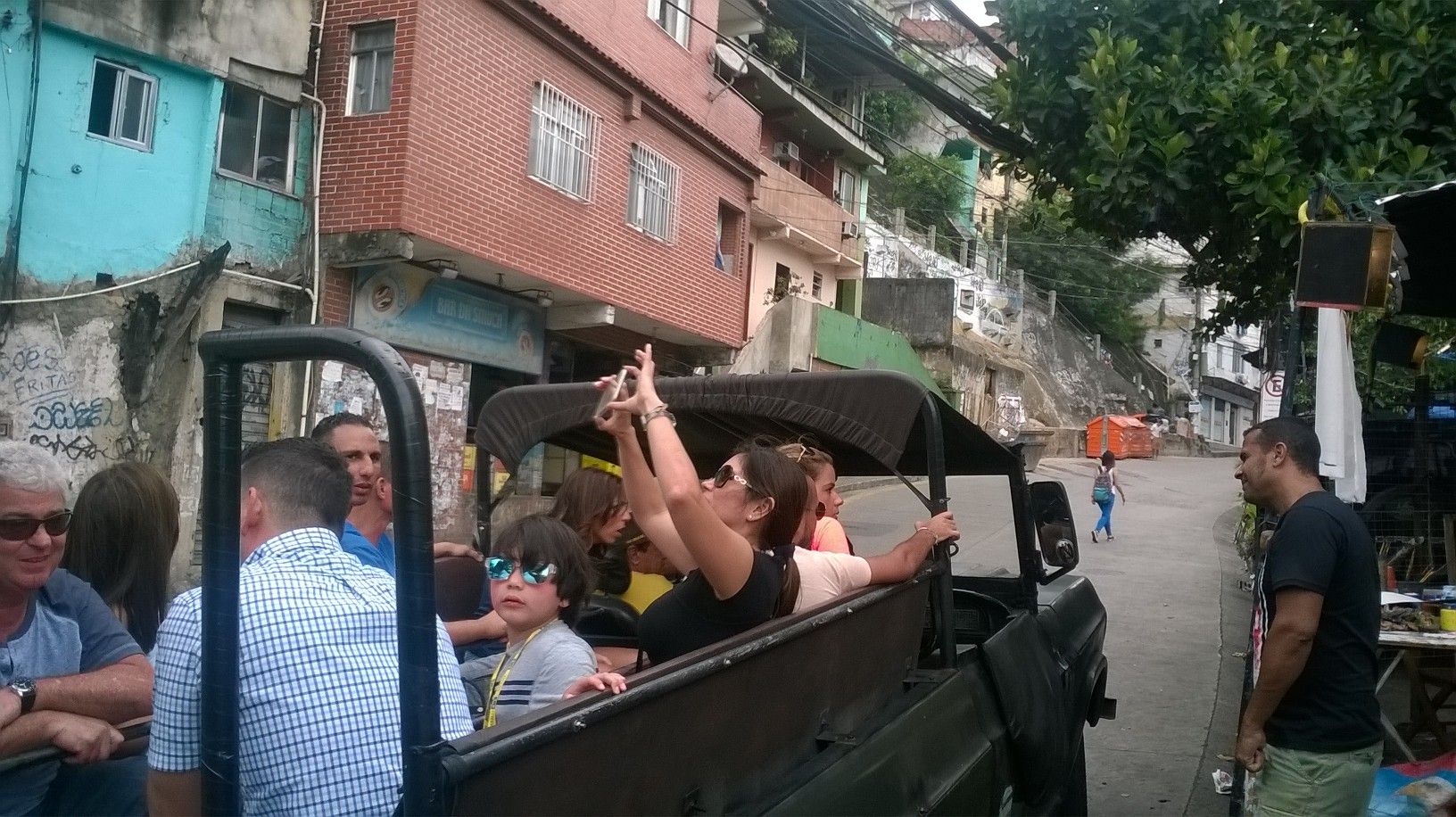
Rio de Janeiro
UI/UX
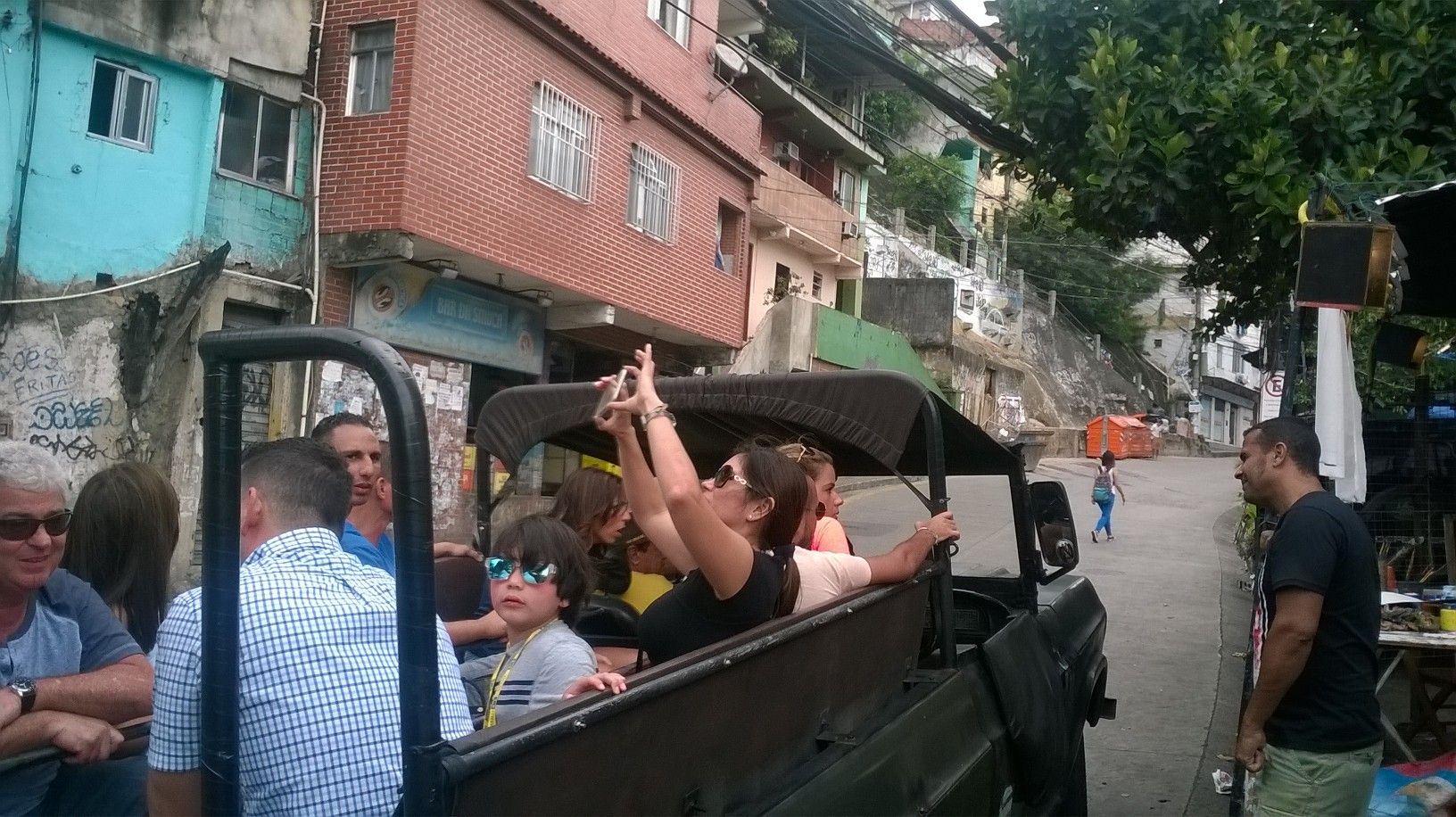
Tourists visit the Rocinha favela in a safari-like jeep, November 2015.
From the 1990s onwards, the recognition of the cultures of urban poor populations living in informal settlements, townships or favelas became an integral part of intervention programs such as the Favela Bairro. The aim was to use favela’s internal activities and cultural forms (materialized in samba schools, baile funk parties and so on) as levers for economic activity as well as instruments for de-stigmatizing working class populations hitherto labelled as ‘lazy’ or ‘dangerous’. In the 2000s, such cultural phenomenon became widespread and the depiction of urban informality in globally successful films such as City of God (2002) and Slumdog Millionaire (2008) was the sign of a global re-appreciation of vernacular architectures, ecologies and urbanisms. Ananya Roy (2011) picked up on Danny Boyle’s film title to help her describe the idea of ‘subaltern urbanism’, which aims to dislodge apocalyptic and dystopian narratives of the slum and instead affirm it as “a terrain of habitation, livelihood and politics, (…) conferring recognition to spaces of poverty and forms of popular agency” (Roy 2011: 224) often neglected in urban theory. The point is the power of popular culture to frame previous or ongoing debates and imaginations of what life is like in the informal city across the world.
The Slum Tour
One of the most visible elements of this cultural background is the tour of the slum. Anthropology, Cultural Studies and Tourism researchers (e.g. Freire-Medeiros 2009, 2011; Rolfes 2010; Durr 2012) have opened a field of inquiry on the theme, asking important “critical questions regarding the commodification of the most vulnerable social groups and want[ing] to know who actually benefits from” activities such as slum tours or identical initiatives (Durr 2012: 707). There are variegated answers to these questions, ranging from touristic activities set up by middle-class individuals from outside the settlements which ultimately do not produce a great deal of investment in the area, such as those at Rocinha in Rio (Freire-Medeiros 2011: 28; main image); to tours and activities set up by residents themselves, who despite having to navigate the same media landscape and touristic system to canvass for clients are still able, for example, to provide decent salaries for tour guides from the neighbourhood and overall play a part in improving the settlement’s social image for the rest of the city. To use an example from the same city, some tours in the Santa Marta favela in Botafogo belong to the latter group. They strategically use national and global media to draw attention to the neighbourhood (e.g. by inviting the Netherlands football team to visit the neighbourhood during the World Cup 2014) but are able to capture some investment into the place, via bars, souvenir shops and baile funk parties (research observation, 2015, author).
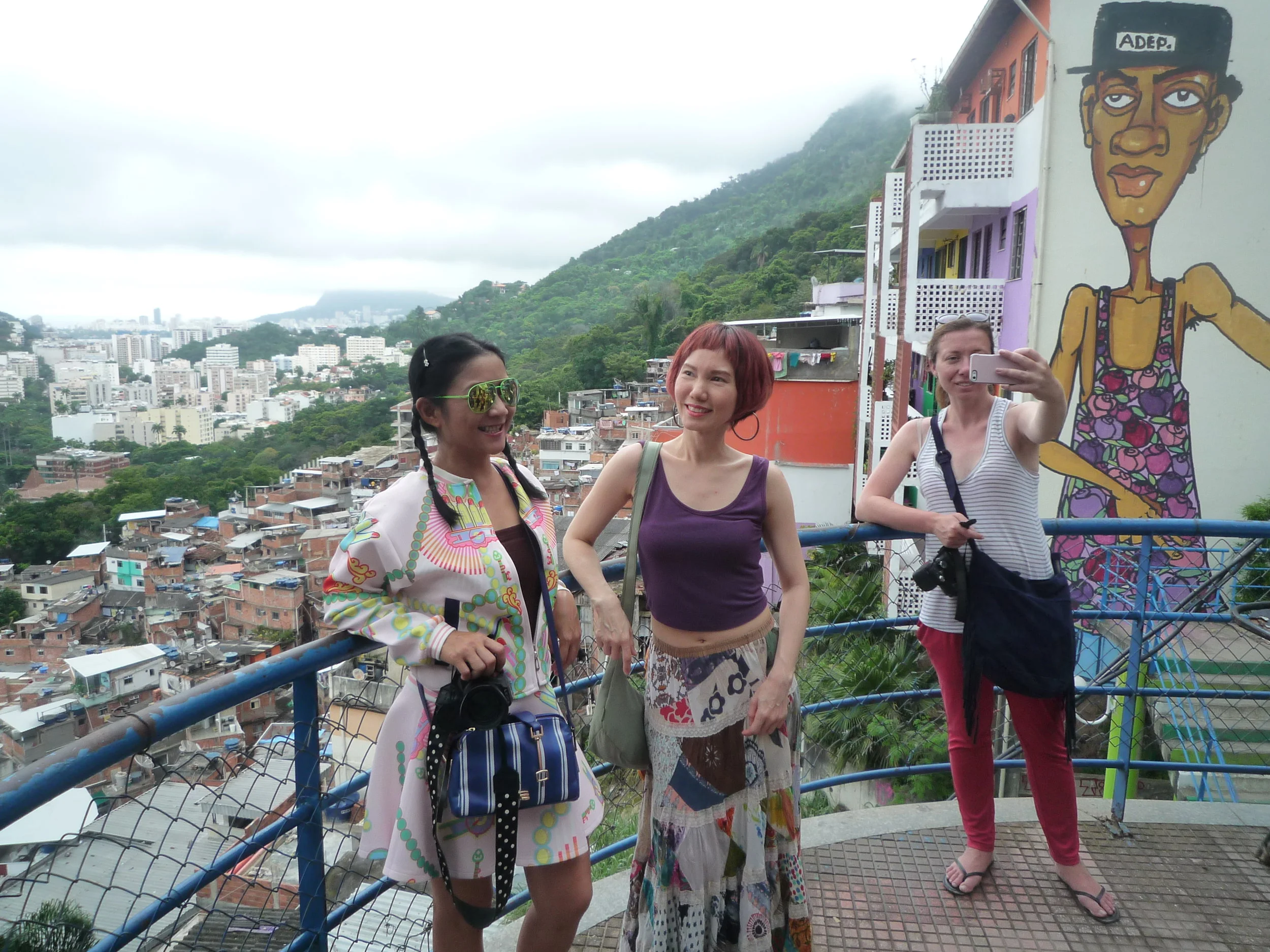
Tourists take pictures in Favela Santa Marta, Nov. 2015.
However, more often than not slum tours serve imaginaries which are re-composited elsewhere and have little or no relation to the ‘habitation, livelihoods and politics’ (Roy 2011) at the specific sites they guide tourists through. Freire-Medeiros (2011) notes how tourists go to Rocinha to get a sense of the City of God they saw on film, while actually not going to the real City of God (Cidade de Deus) housing estate, located more than 20km from the touristic Zona Sul. Cidade de Deus was initially built to rehouse residents evicted from favelas in Zona Sul in the 1960s; then underwent a process that Brazilian academics refer to as re-favelization; and in the last decade has seen the further construction of housing estates for more recent favela evictees under the Minha Casa Minha Vida (My House My Life) federal housing program. It is a very interesting case, but as it does not fit well with tourists’ existing imaginations of the slum they want to experience (narrow alleyways, steep terrain and spectacular views to the rest of the city) nor with the practicalities of visiting and getting back to hotels within a tight schedule, it is not visited. In sum, answers to questions regarding the benefits of slum or poverty tourism oscillate between the two extremes; and research that provides further empirical evidence on the topic from different places across the world is very welcome.
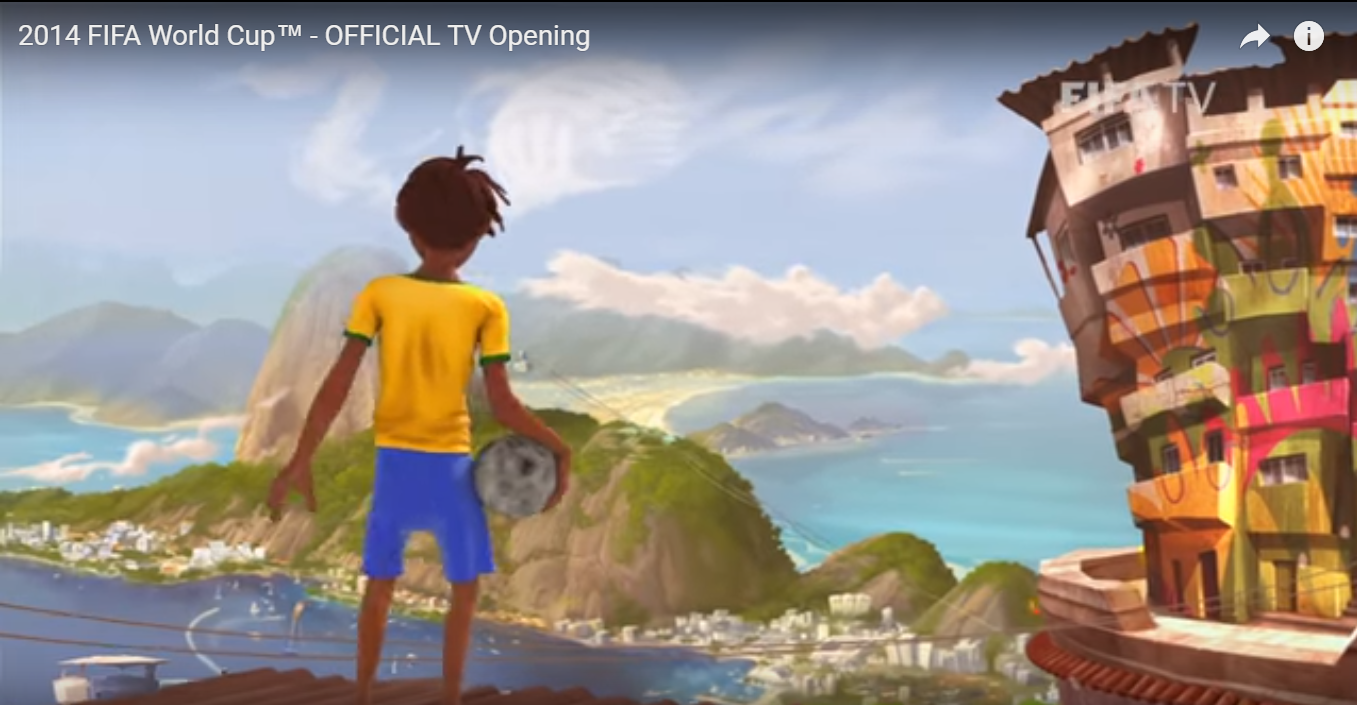

Stills from the 2014 World Cup Title Sequence. Images by FIFA.
The underlying tension between the increased visibility of informal settlers’s cultures and what that means for their everyday life remains. It is clearly expressed in one global cultural snippet, the animation title sequence which preluded the television broadcasts of the 2014 Football World Cup games. The colorful animation showed a boy from a favela ‘flying’ across Brazil to look at all the stadia or touristic features of the host cities but, in a brutally telling final scene, it showed he did not go into the Maracanã stadium to watch the game; instead, it showed him watching it from the top of his favela. The not-so-subliminal message – which was broadcast to 207 countries and territories reaching over 2 billion viewers – is that poverty and the positive attributes of favelas (such as youthful joy or creativity in the face of adversity) are celebrated; but the boy (and by metonym the rest of the favela residents) is still not invited to the party. Furthermore, this scene reproduces with exactitude actual events related to the urban and social segregation of favela inhabitants in Rio’s social landscape, something which international photojournalists did not miss during the following 2016 Olympic Games, seen for instance in Reuters’ Ricardo Moraes photograph of Mangueira residents watching the opening ceremony from their laje, the favela dwelling’s rooftop.
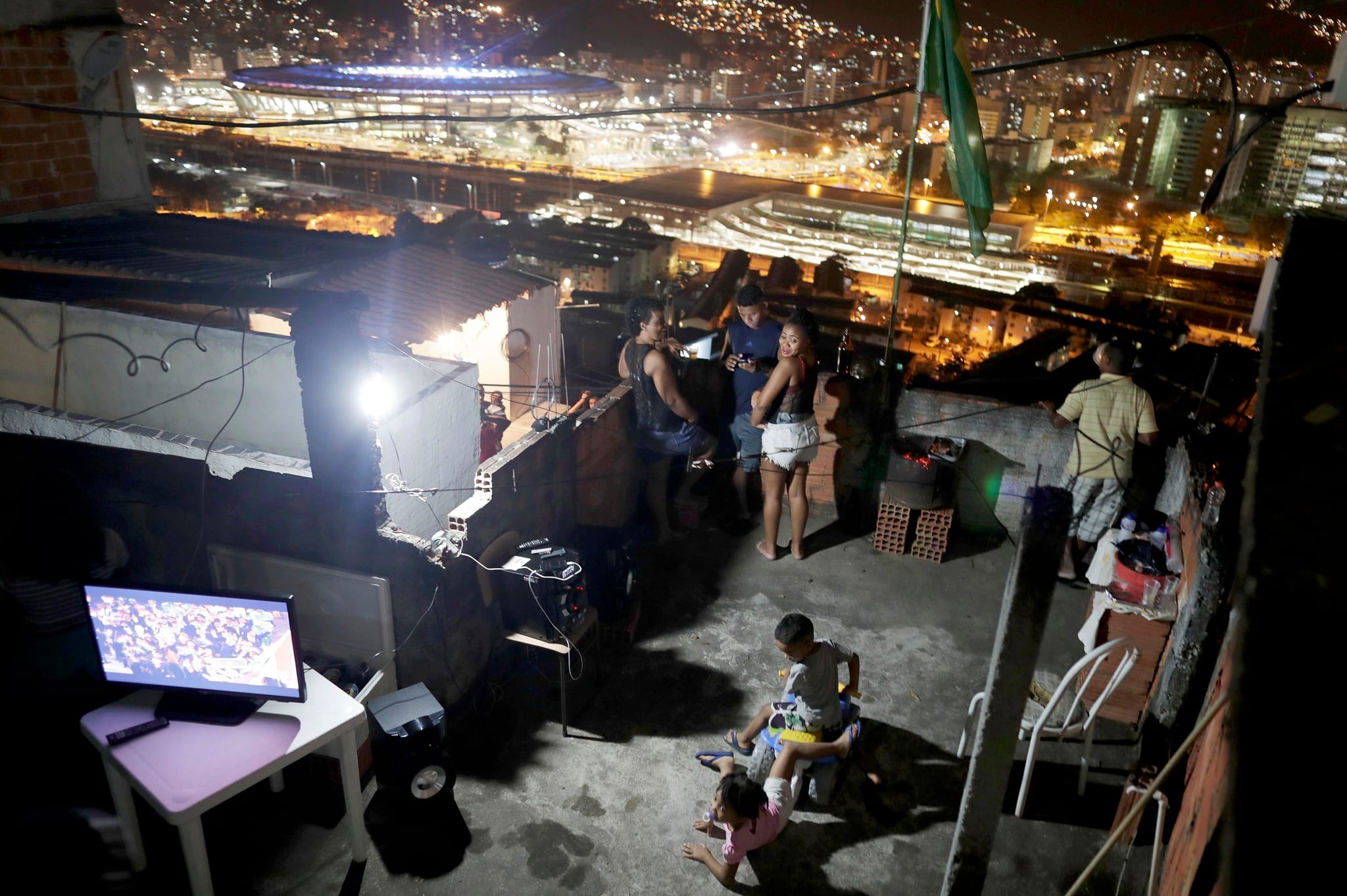
Mangueira residents watch the Olympics Opening Ceremony, Aug 2016. Photo by Ricardo Moraes, Reuters.
A final note goes to the way some informal areas have seen museums dedicated to their history appear. One of the most accomplished is the District Six museum in Cape Town, South Africa (www.districtsix.co.za). It preserves the memory of the historical case of eviction of black residents during the Apartheid regime from a working-class central area, which was deemed a slum and declared as a white area under Apartheid legislation in 1966, with forced removals starting in 1968. Around 60,000 people were relocated to the Cape Flats Township 25 km away. In 1994, a ‘memory museum’ focusing on residents’ accounts, old memorabilia and a map survey of where people’s houses stood opened. One of the museum objectives is to preserve this history of forced removals and engage with current similar struggles. In Rio de Janeiro, the Museu da Maré in Complexo da Maré shows the history of the fishing villages which existed in the area throughout the 20th century and also works in tandem with NGO Redes da Maré as a community organization (http://redesdamare.org.br).
In short, mass culture which explores the slum theme – be it from the outside or from within informal settlements – draws the general public’s attention to real or imaginary sites of informal urbanism. It re-interprets the informal city with its specific methods and forms; produces a synthesis; and instills a curiosity about specific places that may generate income and recognition as well as, further down the line, pioneer gentrification.
References
Dürr, E. (2012) Urban Poverty, Spatial Representation and Mobility: Touring a Slum in Mexico, International Journal of Urban and Regional Research, 36.4, 706–24.
Freire-Medeiros, B. (2009) The favela and its touristic transits, Geoforum, 40, 580–588.
Freire-Medeiros, B. (2011) ‘I went to the City of God’: Gringos, guns and the touristic favela, Journal of Latin American Cultural Studies, 20.1, 21-34.
Rolfes, M. (2010) Poverty tourism: theoretical reflections and empirical findings regarding an extraordinary form of tourism, GeoJournal, 75, 421–442.
Roy, A. (2011). Slumdog cities: Rethinking subaltern urbanism, International Journal of Urban and Regional Research, 35.2, 223-238.